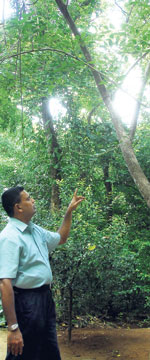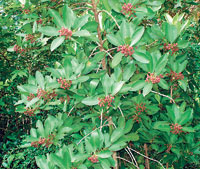Almost every morning before he goes to work, Damitha Rajapakse stops by the property near his home in Gampaha. Standing there amidst the trees and tangled vines, amidst the birdsong and the cool morning air, he is refreshed and renewed in his determination to see this garden flourish, as a resource of the country’s wild fruit heritage.

How does his garden grow: Damitha Rajapakse explains. Pic by Sanka Vidanagama |
His is one man’s effort to create an arboretum.
There are over a hundred different species in the sloping one-acre plot of land and they are all trees, bushes and vines that he has over the years painstakingly gathered and grown, planted and nurtured with extraordinary devotion. Milla, Bovitia, Palu, Mora, Koon, Thimbiri, Himbutu, Maadan, Batakirilla, Batu Keena, Embilla, Meegonkarapincha - he knows them all and points them out with pride as he walks us through his garden.
Most of the trees now thriving here, their branches stretching skywards are natives of the Dry Zone, a region that Damitha loves, others from Sinharaja and remote parts of the island. He himself was born in Alawwa and raised in Kandy but his work has taken him travelling extensively and it is the Dry Zone that exerts a particular fascination for him. Struck by the changing vegetation of the different regions, he noticed the lack of appreciation for the wild fruit trees among many today, particularly urban dwellers, even though they may have enjoyed such fruits in their childhood. “I felt we were in danger of losing an integral part of our heritage,” he says.
The feeling grew that he should do something that would bring to a larger view the unique value of these wild fruit trees and medicinal plants not just from the perspective of highlighting traditional knowledge but also because they can be of use in our modern world. “Wherever I went, I would ask the villagers ‘What are the trees that bear fruit?’ The second question was whether we could eat it or birds could eat it. Often the next time I was there, they would have a plant for me.”
Once he had the land, initially just an uncultivated plot off the main Kandy Road at Orutota -an hour’s drive from Colombo, he made a list of people, identifying those like poet and author Piyasena Kahandagamage who had an interest in traditional knowledge, then ayurvedic doctors and botanists and lost no time in writing to them. Explaining his interest in preserving these indigenous wild fruit trees, he asked if they would share their knowledge of the uses of these varied species. The response was quite staggering, he says, showing us a file full of letters, most handwritten, encouraging him and some even blessing him for having undertaken such an effort.
 It wasn’t all easy. People were initially discouraging, warning that the land was unsuitable for tree planting but Damitha was not deterred. Erosion control was the first step, he says, taking in the contours of the land and this he has done with kalugal and carefully cut terraces. Once the saplings were planted, all he did was water them, initially using cow dung and dry leaves as manure, the rest just left to nature. “Most of the trees were planted with my two hands,” he says proudly. It wasn’t all easy. People were initially discouraging, warning that the land was unsuitable for tree planting but Damitha was not deterred. Erosion control was the first step, he says, taking in the contours of the land and this he has done with kalugal and carefully cut terraces. Once the saplings were planted, all he did was water them, initially using cow dung and dry leaves as manure, the rest just left to nature. “Most of the trees were planted with my two hands,” he says proudly.
The knowledge he has garnered over the years he is now seeking to document. Ever willing to talk of his beloved trees, his conversation is spiced with fascinating tidbits-that there are seven species of timber that should be used in a home, 12 species that bring prosperity to your home, and equally others that are considered inauspicious if planted in front of your home, and still others that have unique medicinal properties.
It is such traditional knowledge that must be collected he says, stressing that the ethno-botanical value is what interests him. Such native knowledge is fast disappearing and by documenting it, it could be utilized for scientific research if the need arises, he feels.
Vital too is the building of a gene bank, in the current context of land fragmentation and forest degradation. “If someone wants to propagate these species, there is a gene bank here,” he says.
After a few years of gathering and planting Damitha has sought to put his effort on firm ground. His initiative known as the Native Forest Foundation had technical support from the World Conservation Union-IUCN in the initial stages, and the University of Kent UK with regular visits from foreign volunteers and university students interested in plant conservation. The house he has built at the entrance to the property, that functions as a resource centre and guest house is again testimony to his earthy practicality, cool and open, brick walled with high roofs and the timber he talks of used in its construction.
Damitha is intent also on imparting green values to the youngsters of today. His Sundays are now spent visiting temples and churches, (20 so far), talking to Sunday School groups about the need to rediscover and nurture this heritage.
It is not a subject that will instantly attract the kids of today, more attached to their TV screens, computers and video games but his modus operandi is simple. He gets their attention by telling them how in the days before toothbrushes, our ancestors used a certain tree bark, Moonamal (Mimusops elengi) for the purpose. His favourite story is of the Mee tree (Madhuca Longifolia) and why farmers planted it in the paddy fields. The fruits of the Mee tree attracted fruit bats, he says and the bat droppings were good manure.
He then distributes saplings and after the interactive session, the kids get to plant them. The interest is tremendous once they have got their hands dirty, Damitha says and surely this is what he loves best too, the times when he can escape into the forest and get his hands into the soil.
Deeper into the arboretum, he points out the trees that the birds love, the Nava- favourite of the koha and the Davul Kurundu.
Then the Ulkanda, Korakaha, Gatakula, Batakirilla, Ilapath habarala – the bush trees that he recommends for landscaping. These trees give shade and you are rendering a service to the country by preserving endemic species, he says. It puzzles him that people don’t think of planting these trees in their home gardens, however small, thereby attracting the birds and insects rather than some merely decorative imported palm.
“I have been emphasising to all landscapers I meet why not go for fruit bearing trees or use plants like these for landscaping instead of ornamental palms. The Korakaha (Memecylon umbellatum) for instance is a lovely bush and it also has an antiseptic value. In the old days in the paddy threshing floor, they prepared a broomstick with these sticks,” he says.
A leafy avenue bordered by tall trees and creeping vines that runs the length of the arboretum ends in an extent of land, unforested for now. If Damitha had the resources he would be extending his arboretum here. The blueprint is all in his mind, but he needs funds, maybe about Rs 5 lakhs he mentions wistfully- to develop it, terrace it to prevent soil erosion and then fill it with more of his precious wild fruit and medicinal trees.
His hope is that someone will understand and support this work that he has carried on virtually single-handed for the past seven years. The trees towering behind him, in verdant profusion are all the evidence one needs.
|


 It wasn’t all easy. People were initially discouraging, warning that the land was unsuitable for tree planting but Damitha was not deterred. Erosion control was the first step, he says, taking in the contours of the land and this he has done with kalugal and carefully cut terraces. Once the saplings were planted, all he did was water them, initially using cow dung and dry leaves as manure, the rest just left to nature. “Most of the trees were planted with my two hands,” he says proudly.
It wasn’t all easy. People were initially discouraging, warning that the land was unsuitable for tree planting but Damitha was not deterred. Erosion control was the first step, he says, taking in the contours of the land and this he has done with kalugal and carefully cut terraces. Once the saplings were planted, all he did was water them, initially using cow dung and dry leaves as manure, the rest just left to nature. “Most of the trees were planted with my two hands,” he says proudly.